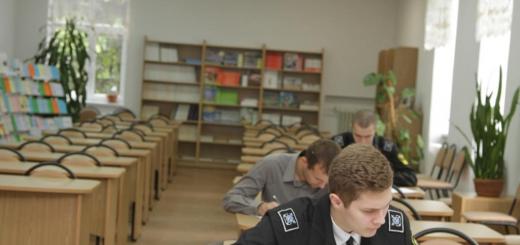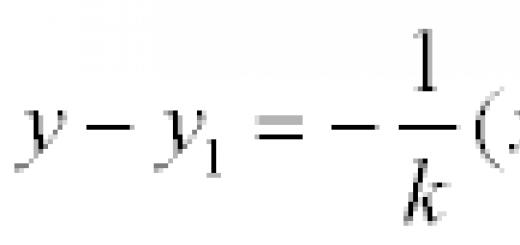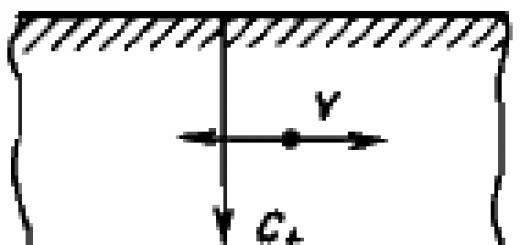The phonetic system of the French language includes 15 vowels, 17 consonants and 3 semivowels, for a total of 35 phonemes. The Russian language has 5 vowels, 1 semi-vowel and 36 consonants, for a total of 42 phonemes. Despite the fact that in quantitative terms (35 phonemes and 42 phonemes) the difference between the French and Russian languages is small, there are large differences in the phonetic system of these two languages. In Russian, consonants predominate; in French, vowels predominate.
Each language has its own historically developed system of phonemes, and each language has its own characteristics of sounds that have a semantic-distinguishing function. All this determines the main features of the pronunciation of the sounds of a given language. Thus, French sounds, compared to Russian ones, are characterized by greater clarity and stability of articulation. Hence the consonants absence stun And mitigation(in French, only two phonemes are an exception - [k], [g]); vowels have no reduction(change in the quality of a vowel in an unstressed position). For example, the word dresser pronounced in Russian [kamot], where the unstressed O is read as [a], and also stuns the final d. In French this word would be pronounced [chest of drawers].
Now let's turn to the prosodic means of language, i.e. phonetic means realized in a word, phrase, phrase, text, such as intonation And emphasis. And here, first of all, you need to pay attention to the means of intonation: pace, melody. Pace French speech faster than Russian. This is especially true for informative speech (for example, radio broadcasts) and colloquial speech. Melodica– the most important component of intonation. And in this regard, the main differences in Russian and French are as follows: the melody of French speech smoother and smoother, in Russian the tone movement is more variable; The range of French intonation is wider than Russian.
French accent fixed, it is always falls on the last syllable a single word, phrase or entire phrase. In Russian, stress varies and can refer to any syllable in a word and word in a sentence.
In French the following phenomenon also plays a significant role. A French word in speech often loses its independence, its emphasis and phonetic boundaries. In other words, words seem to merge into one single whole (called rhythmic group), in which it is extremely difficult for an inexperienced person to identify a single word. For example, in Russian in the phrase I already opened it may have phonetic linking of words, but it is not necessary. In French, words are linked together, and the same phrase would sound like this [I've already opened it]. At the same time, this happens often, but not always. There are certain rules by which this connection of words occurs.
As we already found out in the previous article, the French language has its own melody. In addition, the distribution of stress in French differs from Russian and Ukrainian languages. Let's compare:
in Russian - ‘We watched’ a good’ film
in French - Nous avons 'vu un bon 'film.
N.B.: hereinafter, icon ‘ the stressed syllable will be indicated.
We see that in Russian every word has stress, but in French only the words “vu” and “film” are stressed. Why is this happening? It turns out that the French sentence must be divided into rhythmic groups, depending on which the stress will be distributed.
The concept of “rhythm group” is quite difficult to define, but let’s try to figure it out. Rhythmic group in French - this is a unity of words that have a grammatical and/or lexical connection, with stress on the last syllable (For example, in the sentence: Nous avons vu un bon film 2 rhythmic groups - 1.nous avons vu and 2. un bon film. Nous avons cannot exist without the word vu, then this expression will have a different meaning “we have”, that is, there is a grammatical and lexical connection between the words nous, avons, vu). All syllables in a French sentence have the same duration and intensity of pronunciation, but at the end of a rhythmic group the last syllable is longer than the others, that is, it is percussion. Therefore, the French sentence is different from the Russian one.
A very difficult point to explain is the rule for identifying rhythmic groups in the French language. In many textbooks, its explanation is difficult to understand even for philologists, but I tried to highlight the key points, I hope that they will help you cope with this difficult task.
Rules for identifying rhythmic groups in a French sentence:
1. The two most important parts of speech for identifying rhythmic groups are verb And noun , all other words are service words (articles, prepositions, auxiliary verbs, linking verbs, personal pronouns, numerals, demonstrative and possessive adjectives), that is, they occupy secondary positions when identifying rhythmic groups (and cannot form separate rhythmic groups):
Elle 'parle - 1 rhythmic group (one main word - verb).
Ma'rie 'parle - 2 rhythmic groups (two main words - verb and
noun)
2. You should pay attention to this nuance: if a noun acts as a direct object (I remind you that the direct object answers the question: who? what? - accusative case), then it does not form a separate rhythmic group:
Le bar'man vous a embrassé la 'main. - 2 rhythmic groups (the word “la main”, although it is a noun, acts as a direct object, and therefore does not form a separate rhythmic group: kissed whom? What? - hand).
3. An important point in identifying a rhythmic group is the position and number of syllables in the adjective. So, if the adjective is monosyllabic (i.e. has one syllable), then it will in any case form one rhythmic group with the noun: un film ‘russe. But, if the adjective is worth AFTER noun and has several syllables, then it can form another rhythmic group: un ‘film intére’ssant (2 rhythmic groups).
4. “Frozen” phrases (those that express one concept) form a separate rhythmic group: de temps en 'temps, l'arc - en - 'ciel, une salle de 'bains.
5. There is a rule: several stressed syllables cannot exist within one rhythmic group, therefore:
Elle tra'vaille But: Elle ne travaille 'pas (we know that the stress in a rhythmic group always falls on the last syllable, the word “pas” is an auxiliary part of speech and cannot form a separate rhythmic group, at the same time, it is the last word in a sentence, therefore the word "travaille" loses its phrasal stress in favor of "pas").
This topic is very extensive to explain, but I hope that I was able to describe the main points that you should pay attention to in order to understand the principles of identifying rhythmic groups in French!
In the introductory course we will look at the sounds of the French language, giving, where possible, their approximate sound correspondences in the Russian language and showing for each sound which French letters or letter combinations it is conveyed.
Introductory phonetic the course consists of 12 lessons and Not includes grammar
Sounds [a], [p], [b], [t], [d], [f], [v], [m], [n]
| French sound | Similar Russian sound | French letters and letter combinations | Notes |
| vowel [a] | [a] as in the words br A t, d Aн, i.e. like [a] under stress before soft consonants | Ah, ah À, à |
The ` icon is used to distinguish certain words in writing, for example: A- It has ( verb form); à - a preposition conveying the meaning of the Russian dative case(to whom; to what?) and other meanings. Uppercase letter À more often referred to as A. |
| consonant [p] | [p] as in the word P ar | P, p | Don't confuse uppercase and lowercase French letters P,p with the Russians R, R! |
| consonant [b] | [b] as in the word b ar | B, b | Don't confuse capital French letters B from Russian IN! |
| consonant [t] | [t] as in the word T az | T,t Th, th |
|
| consonant [d] | [d] as in the word d ar | D, d | |
| consonant [f] | [f] as in the word f Act | F,f Ph, ph |
|
| consonant [v] | [in] as in the word V al | V, v W,w |
Letter W,w is rarely used and is read as [v] in certain borrowings from other languages, for example in the word w arrant - guarantee. |
| consonant [m] | [m] as in the word m ak | M,m | |
| consonant [n] | [n] as in the word n ash | N,n |
Please update/change your browser if you experience problems with the audio player below.
Exercise No. 1. Say clearly and forcefully:
[ra - ba - ta - da - fa - va - ma - na].
Exercise No. 2. Write the transcription opposite the letter or letter combination. Test yourself using the table above.
| Sample: |
| T[ ] | f[ ] | t[ ] | F [ ] |
| d [ ] | p [ ] | à [ ] | a[ ] |
| A [ ] | B[ ] | b[ ] | ph [ ] |
| D [ ] | Ph[ ] | n [ ] | V [ ] |
| M [ ] | N [ ] | Th[ ] | P[ ] |
| m [ ] | v [ ] | th [ ] |
Exercise No. 3. Read the sounds from the transcription, not forgetting about their clear and full-voiced pronunciation. Test yourself using the table above.
[n], [b], [m], [d], [a], [f], [p], [v], [t].
Consonants at the end of words
The rule also applies to all those consonants that you will study further: at the end of words they do not undergo any changes and sound as clearly as before a vowel sound.
Watch yourself: read Russian words out loud ra b, ra d, ro V. What do you hear at the end of words? You hear:[ra P], [ra T], [po f]. Never make such substitutions in your French speech!
Exercise No. 4. Say, clearly contrasting the final sounds:
, [rar - pab], , , .
If the word ends with the sound [v], then any stressed vowel
in front of it, as a rule, lengthens, for example.
The colon in transcription indicates the length of the vowel.
Exercise No. 5. Pronounce, distinguishing the final ones[f] And[v]:
, , .
Letter e at the end of words. French accent. French vowel clarity
Letter e at the end of words is in most cases unreadable, for example:
dam e- lady, Arab e- Arabic, -aya, -oe.
The stress in French words falls on the last syllable, for example: papa - dad. It will not be indicated further in the transcription.
All French vowels sound equally distinct and bright as if under stress,
and in an unstressed position, for example: panama - Panama.
All three [a] are pronounced equally energetically and are not “swallowed” or changed.
Exercise No. 6. Read, not forgetting that the stress in French words always falls on the last syllable:
Sound [r]
It is believed that the sound [r] in Parisian pronunciation is one of the most difficult French sounds for Russians. However, Paris, according to academician Shcherba, is not all of France, and since in the provinces there is a pronunciation of this sound close to Russian, insofar as the Russians can stay with their[R]. It is only necessary to follow the general rule of pronunciation of French consonants: at the end of words [r] sounds as distinct and tense as in other positions. Listen to yourself: say the words out loud R ab - ba R, R hell yes R, R Anna R. You will hear that [r] at the end of words in each pair sounds much weaker than at the beginning of words. So, make sure that the final [p] does not differ from the initial one, - and do the same in your French speech!

For those who still want to get closer to Parisian pronunciation, we advise you to do the following. Loudly, with pressure, as if you were answering someone angrily, say Russian words but G ah, duh G oh and watch how you pronounce the sound [g]. Then calmly, as if thoughtfully, say the words a G a!, oh G O! - and you will notice that the letters are in place G a completely different sound is pronounced - as if there were no obstacles in its path in the oral cavity. Remember this sound well - it is also similar to the [g] that we hear in the Russian speech of people speaking with a Ukrainian accent. Pronounce the Ukrainian sound [g] instead of the French [r]- This is an option that is quite acceptable for beginners.
Finally, those who pronounce the Russian sound [r] burly - either by nature or as a joke - can transfer this skill to their French speech. Burry Russian [r] instead of French [r] is also suitable.
So, we offer you three options for pronunciation of French [r] - the choice is yours!
Exercise No. 8. Read:
If the word ends with the sound [r], then any stressed vowel
in front of it, as a rule, lengthens, for example:
bar - bar, amarre - anchor chain.
Exercise No. 9. Read:
Exercise No. 10. Practice writing by tracing the outlines of French letters with a pencil (not on the monitor!). The French often write in block letters - you can learn this too.
| t | A | P | f | F | a |
| à | M | N | P | B | ph |
| T | m | v | b | Ph | V |
| d | Th | D | n | r | R |
Unlike the Russian language, in which the stress can fall on any syllable of a word and even move depending on the form of the word (nogá - nogi), in French the stress in an isolated word always falls on the last pronounced syllable:
chocolat [ʃɔ-kɔ-΄la], discuter, nationalité
Stress in the speech stream rhythmic group and rhythmic stress
Stress in the speech flow in French is distributed completely differently than in Russian.
In Russian, when words are combined into semantic groups, each word of such a semantic group retains its stress. Compare: ΄He΄writes.
΄He΄writes | business letter.
In French, the stress in the speech flow is carried by the semantic group as a whole, and not by individual words. That is, the semantic group becomes a group of one stress (rhythmic group). This means that in a French phrase there will be as many stresses as there are rhythmic groups with stress on the last syllable (and not as many words as in Russian). Compare:
Il écrit.
Il écrit | une lettre officielle.
The rhythmic group is:
An independent word with function words related to it:
Une assiette
Il bavarde
Nous ne cryons pas
Defined word with defining words preceding it:
C'est une très bonne galette.
A qualifying word followed by a monosyllabic qualifying word:
Il parle bas
une jeune fille brune
Historically established sayings and groups of words that express one concept:
soixante-dix
tout le monde
Note. To correctly place stress in French, you need to remember the basic rule of French rhythm: there are no two stressed syllables in a row in a rhythmic group. Consequently, any significant word preceding a monosyllabic word that completes a rhythmic group loses its stress. For example:
Je bavarde [ǝ-ba-΄va:rd].
But: Je ne bavarde pas [ǝ-nǝ-ba-vard-΄pa]
Additional emphasis
In French there is not only a rhythmic stress placed on the last syllable of a rhythmic group, but there is also a secondary stress (and often secondary stresses) appearing in long rhythmic groups.
Additional stress should be placed on odd syllables, if counted from the end of the rhythmic group. The additional stress is not the main one (which is the rhythmic one) and differs in pitch, not in strength:
Madame Pascal n'est pas occupée.
Dansez-vous? [´´dᾶ-se-´vu]
Il ne bouge pas.
Additional stresses also occur within one word:
L'organisateur [´´lɔr-ga-´´ni-za-´tœ:r].
LINKING SOUND IN THE SPEECH STREAM
In the French flow of speech, it is difficult to understand where the boundary between words in a sentence lies, since the words are not separated from each other, as happens in Russian, but, on the contrary, merge together.
This “merging” of words is explained by such typical phonetic phenomena of the French language as clutch(enchainment), voicetying(liaisonvocalique) and tying(liaison) sounds in the speech stream. It is thanks to these three phonetic phenomena of French speech that a continuous flow of sounds occurs from pause to pause and produces that very impression of the musicality of French speech, known to many.
in French
French is famous for its complex spelling. Such a number of silent letters, that is, letters that are not pronounced, as well as combinations of several letters that are read with one sound, are not found in any other European language. This is due to the history of the development of the language and the national characteristics of its people - the French do not want to forget their ancestors and, in tribute to them, they retain their complex written language, but constantly simplify their oral speech.
If you accept the fact that you don’t need to read some of the letters, then reading French is quite easy, but writing it is much more difficult. And by ear, there is very little chance of spelling a word in French correctly if you have never seen how it is written, which is why it is so important to read books in French. Only books can help you learn French spelling.
For Russian speakers, there is a certain difficulty in mastering French pronunciation, since it contains a number of sounds that have no analogues in the Russian language. But these sounds are few and quite easy to master.
The French language uses the Latin alphabet, there are no letters of its own, but there are letters with so-called diacritics (dashes, sticks, checkmarks and dots above the letters), which we will consider below
Let's move on to the reading rules.
Vowels and their combinations
In general, vowels are read fairly standardly: a [a], e [e], i [and], o [o], u [y], y [and]
But they have some peculiarities
1. Letter e:
- in an open unstressed syllable reads like [œ] - something in between o, e and e (we put our lips together as to pronounce o, but try to pronounce e)
- at the end of a word of several syllables it is not readable at all
2. Letter u read as something between u and yu (as in the word tulle)
3. Letter y:
- between vowels it is read as [th] ( royal).
- between consonants is read as [and] ( style).
4. Before the consonant sounds [r], [z], [zh], [v], [v], stressed vowel sounds become long: base [baaz].
Vowels with diacritics (dashes and sticks)
Above French vowels we often see various dashes, sticks, ticks, dots, etc. This is again a tribute from the French to their ancestors, since these symbols mean that next to this letter there used to be a consonant, which is no longer written. For example, the word holiday fête came from a Latin word and lost the letter s in the middle, but in the Russian word of the same origin “festival” and the Spanish “fiesta” this letter remained.
In most cases, these symbols do not affect pronunciation, but help to distinguish similar words by meaning, but you will not hear this difference by ear!
You only need to remember the following options:
- è And ê read as [ɛ] (like Russian e): tête.
- é read as [e] (like the e in a smile): tele.
- If there are two dots above a vowel, then you just need to pronounce it separately from the previous one: Noël, egoïst
Special vowel combinations
- oi reads like [ua]: trois [trois].
- ui read as [ui]: n uit [nui]
- ou reads like [y]: cour [chickens].
- eau andau read as [o]: beaucoup [side], auto [from].
- eu, œu and letter e(in an open unstressed syllable) are read as [œ] / [ø] / [ǝ] (something between o and e): neuf [nave], regarder [regarde].
- ai And ei read as [e]: mais [me], beige [bezh].
Consonants and their combinations
Most of the consonants are read standardly:
b - [b]; s - [k]; d - [d]; f -[f]; g - [g]; h - [x]; j - [j]; l - [l]; m - [m]; n - [n]; p - [p]; r -[r]; s - [s]; t - [t]; v - [in]; w - [ue]; x - [ks]; z - [z]
Features of French consonants:
- h never read
- l always reads softly
- n at the end of a syllable is always read nasally
- r always reads burly
But, of course, there are other options for reading these consonants:
1. consonants are NOT readable (silent consonants):
- The words at the end are unreadable: t, d, s, x, z, p, g, es, ts, ds, ps (rose, nez, climate, trop, heureux, nid, sang; roses, nids, cadets)
- The end of the word is unreadable c after n: unbanc.
- The endings of verbs are not readable -ent: ilsparlent.
- At the end of the word the r after the e is not readable (- er): parler.
Exceptions: in some nouns and adjectives, for example: hiver [iver] , cher [share] mer [mayor],hier [yer],fer [fair] ,ver [ver] .
2. special cases of reading consonants
- double consonants are read as one sound: pomme [pom],classe [class].
- c read as [s] before i, e, y and, if written with a tail at the bottom ç : Circe,garçon , V in other cases it is read as [k]
- g reads like [zh] before i, e, y: courage, inin other cases it is read as [g]: garçon [garcon]
- s between vowels is read as [z]: vase [vaaz]
- x reads:
- at the beginning of a word between vowels like [gz]: exotic
]
- in cardinal numbers as [s]: six [sis], dix[dis].
- in ordinal numbers as [z]: sixième [light blue], dixième[disiem]
- in other cases as [ks]
- t read as [s] before i + vowel: national [national]
3. special combinations of consonants
- ch reads like [sh]: chercher [chershe].
- phreads like [f]:photo [photo].
- gn reads like [н]: ligne [tench].
Special combinations of vowels and consonants
- qu reads like [k]: qui [ki].
- gu before a vowel it is read as [g]: guerre [ger].
- il And ill reads like [th]: travail [travai], famille [surname].
Exceptions: ville [ville], mille [miles], tranquille [tranquille], Lille [lil].
Nasal sounds (n at the end of a syllable is always read nasally):
- an, am, en, em[an]: enfance, ensemble
- on, om[He]: bon, nom
- in, im, ein, aim, ain, yn, ym[en]: jardin
- un, um[yong]: brun, parfum
- oin[wen]: coin.
- ien[en]: bien.
Accent
Simply wonderful news awaits you here! In French, the stress always falls on the last syllable. There are no more rules. There is no such gift for language learners in any other European language.
But remember, if the words are connected or concatenated, then the stress falls on the last syllable of the last word of this construction.
Cohesion and linking of words in French
- Concatenation: the final pronounced consonant of one word forms one syllable with the initial vowel of the next word: el l e aime [elem]
- Linking: The final unpronounceable consonant begins to sound by linking with the initial vowel of the next word: c'es t elle [se tel], à neu f heures [and never].
Apostrophe
An apostrophe is a comma at the top.
Pronouns and articles ending in a vowel lose it and are replaced with an apostrophe if they are followed by a word beginning with a vowel sound
Instead of c e est - c’est [se], l e arbre – l’arbre [lyarbr], j e ai – j’ai [zhe], je t e aim - je t’aim [zhe tem]
If you are in doubt about how to read a word, enter it into any free online translator and click “listen”. Google has such a translator. His French-Russian version of the translator is so-so, but he pronounces the words well :)
Typical mistakes Russian speakers make in pronunciation of French words:
Usually, the easiest way to identify a Russian person speaking French is by the incorrect pronunciation of those French sounds that have no analogues in the Russian language:
- Russians make a sound [œ] like [e], but it should be like something in between o, e and e (we put our lips together as to pronounce o, but try to pronounce e). This sound appears when reading eu and e at the end of a word consisting of one syllable (qu e, f eu, p eu x, m e,t e, c e,v oeu, nerve eu x, s eu l, l eu r, c oeu r, s oeu r)
- we make a sound [u] like a regular [u] or [yu], but you need something in between u and u (as in the word “tulle”)
- carat french r we pronounce it awkwardly
- and we pronounce nasal sounds as simply [n].
- Also, Russians in French often have no difference between long and short vowels
- and too firm pronunciation of the letter l
But even if you say it this way, you will still be understood. It’s better to speak French with a Russian accent than not to speak it at all.










